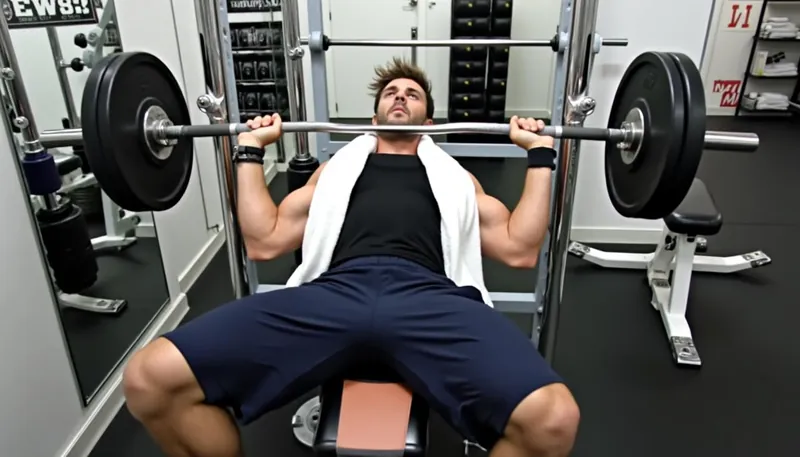Increasing your bench press strength is a quest that many fitness enthusiasts embark upon, often feeling the exhilaration of smashing personal records. It’s more than just lifting a heavy weight; it’s about technique, accessory exercises, diet, and understanding your body. In the world of strength training, particularly for powerlifters, the bench press holds legendary status, often dubbed the “king” of upper body exercises. Whether you’re a seasoned lifter or a beginner looking to break through plateaus, you’ll find techniques here that can help you elevate your bench press game and enhance your overall upper body strength.
Brief
- 🔹 Technique Matters: Proper form can drastically affect your performance.
- 🔹 Frequency Is Key: The more frequently you bench press, the stronger you’ll get.
- 🔹 Accessory Work: Incorporating supplementary exercises is vital for balanced strength.
- 🔹 Nutrition Counts: Fueling your body efficiently influences performance and recovery.
- 🔹 Rest and Recovery: Allowing your body time to recover will help prevent injury and promote muscle growth.
Mastering the Technique of the Bench Press
The bench press is an incredibly dynamic movement that requires attention to detail, especially in terms of technique. A strong foundation in proper form not only helps you lift heavier weights but also significantly reduces the risk of injury. To break it down, the bench press predominantly engages several muscle groups, specifically the pectorals, triceps, and shoulders. Let’s explore some crucial aspects of technique that can elevate your performance.
Grip Placement
Having the correct grip width is essential for maximizing your bench press. A grip that’s too wide can cause shoulder strain, while a grip that’s too narrow could prevent optimal triceps engagement. An ideal grip should place your hands approximately shoulder-width apart, allowing the bar to travel down to your chest comfortably.
Bar Path
One common mistake is an incorrect bar path. Instead of moving vertically up and down, the bar should follow a slight arc. Begin over your lower chest or upper stomach area and then press straight up above your shoulders. This path helps recruit the right muscles while ensuring safety.
Foot Placement and Leg Drive
Foot placement often gets overlooked. Keeping your feet flat on the ground, positioned firmly beneath your knees creates stability and allows for proper leg drive. This is crucial, as driving your feet into the ground activates more muscle fibers and enhances power during the lift.

Breathing Techniques
Breathing might seem basic, but it’s a critical component in lifting heavy weights. A good rule of thumb is to exhale as you push the bar away and inhale as you bring it down. Some lifters also find it beneficial to take a deep breath and hold it (the Valsalva maneuver) before they lift, as this stabilizes the core.
| Aspect | Importance |
|---|---|
| Grip Placement | Ensures optimal muscle engagement and prevents injuries |
| Bar Path | Improves lifting mechanics and effectiveness |
| Foot Placement | Provides stability and aids leg drive |
| Breathing Techniques | Increases core stability and lifting power |
Frequency and Volume: The Backbone of Growth
To see significant improvements in your bench press, frequency is quite crucial. According to research, increasing the number of bench press sessions per week can lead to faster strength gains. But how do you structure your workouts to cover that frequency while managing fatigue?
Integrating Bench Press Into Your Routine
Instead of cramming your bench workouts into a single session, consider splitting them across several days—a proven method for boosting overall results. For example, you might set a regimen that includes:
- 🔹 Hypertrophy Day: 3-4 sets of moderate reps (6-10) at about 75% of your one-rep max (1RM).
- 🔹 Strength Day: 4-5 sets of lower reps (2-5) at a higher weight (~85% 1RM).
- 🔹 Power Day: Explosive lifts with lighter weights (3-4 sets of 3 reps) to improve speed and technique.
Progression and Adjustments
Incorporating progressive overload is essential. Gradually add weight to your lifts, increase the number of sets, or perform more reps as you get stronger. This consistent challenge forces your muscles to adapt and grow.
| Workout Type | Sets | Reps | Intensity (% of 1RM) |
|---|---|---|---|
| Hypertrophy | 3-4 | 6-10 | ~75% |
| Strength | 4-5 | 2-5 | ~85% |
| Power | 3-4 | 3 | ~70% |
Accessory Exercises: The Key to a Stronger Bench Press
Supplementary exercises are fundamental for reinforcing the muscle groups associated with the bench press. By diversifying your workouts, not only do you promote muscle balance, but you also enhance your bench press performance. Let’s look at some must-include exercises that can boost your gains.
Focus on the Chest
The pectorals are the primary movers during a bench press. To strengthen them, consider the following exercises:
- 🔹 Incline Bench Press: Targets the upper chest, improving strength in that area.
- 🔹 Dumbbell Bench Press: Ensures both sides of your body equally engage, enhancing stability.
- 🔹 Chest Flys: Focus on building chest mass and can help with muscle activation.
Tricep Focus for Lockout Strength
Your triceps engage significantly during the lockout phase of the bench press. Developing these muscles can enhance your overall pressing strength:
- 🔹 Close Grip Bench Press: Puts more emphasis on the triceps while maintaining bench specificity.
- 🔹 Tricep Pushdown: An isolation exercise focused on building tricep mass.
- 🔹 Dips: Works both chest and triceps, making them a two-in-one accessory exercise.
| Target Muscle Group | Accessory Exercises |
|---|---|
| Chest | Incline Bench Press, Dumbbell Bench Press, Chest Flys |
| Triceps | Close Grip Bench Press, Tricep Pushdown, Dips |
| Shoulders | Overhead Press, Lateral Raises, Front Raises |
The Role of Nutrition and Recovery
Even the best training regimen won’t yield maximum results without proper nutrition and recovery. Your body requires adequate fuel to perform at its best, with nutrients aiding muscle repair and growth.
Essential Nutrients for Bench Press Success
A balanced diet that focuses on protein, carbohydrates, and fats is crucial. Here’s how to structure your meals:
- 🔹 Protein: Aim for high-quality sources like chicken, fish, and plant-based alternatives. This supports muscle repair.
- 🔹 Carbohydrates: Complex carbs like brown rice and whole grain pasta provide energy for your workouts.
- 🔹 Healthy Fats: Include sources such as nuts and avocados for overall health and energy.
Hydration and Its Importance
Dehydration can significantly impair your strength and recovery. Keep a water bottle handy and track your intake, aiming for at least 3-4 liters daily. Also, consider electrolyte-rich drinks during intense sessions.

Prioritizing Rest
Your body needs time to recover. Without adequate rest, you may experience fatigue and decreased performance. Make sure to get enough sleep, ideally 7-9 hours per night, and incorporate rest days into your workout schedule.
| Aspect | Recommended Practices |
|---|---|
| Protein Intake | Chicken, Fish, Plant-based proteins |
| Carbohydrate Sources | Brown rice, Whole grain pasta |
| Hydration | 3-4 liters daily; electrolyte drinks |
| Sleep | 7-9 hours per night |
How often should I bench press?
For optimal strength gains, aiming to bench press 2-3 times a week is ideal.
Do accessory exercises really help?
Yes! Incorporating accessory exercises specifically targets weaknesses and improves overall bench strength.
What’s the best pre-workout meal for strength?
A meal high in protein and complex carbs about 1-2 hours before training can enhance performance.
How important is rest for muscle growth?
Rest is crucial as it allows muscles to repair and grow, leading to improved strength over time.
Can I increase my bench press without lifting heavy?
You can utilize techniques like paused lifts or higher rep ranges to promote strength without heavy weights.


